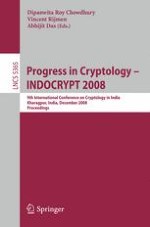2008 | Buch
Progress in Cryptology - INDOCRYPT 2008
9th International Conference on Cryptology in India, Kharagpur, India, December 14-17, 2008. Proceedings
herausgegeben von: Dipanwita Roy Chowdhury, Vincent Rijmen, Abhijit Das
Verlag: Springer Berlin Heidelberg
Buchreihe : Lecture Notes in Computer Science
